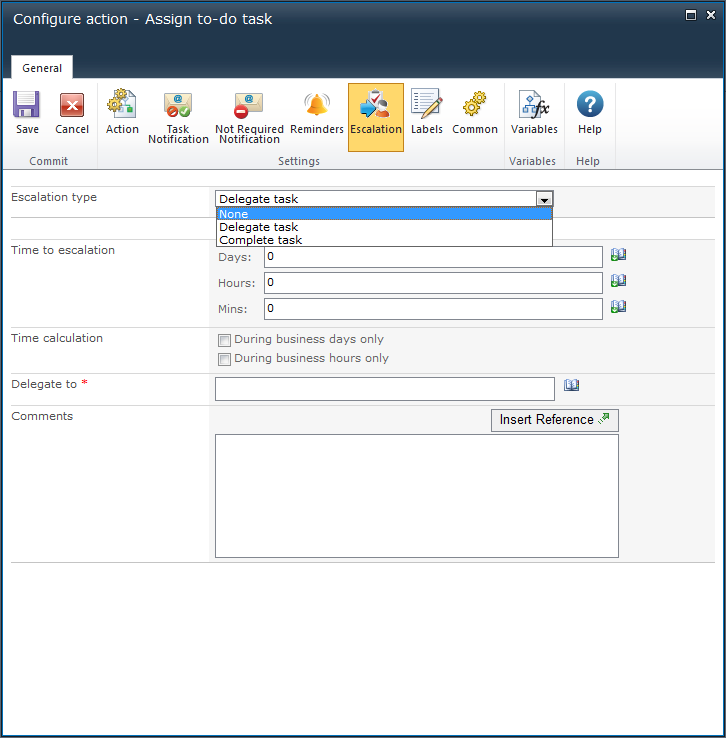








|
 |

|
 |

|
 |

|

|
This workflow action will assign a SharePoint task to one or more users.
To use the workflow action:
Alternatively
To change the settings used by the action:
For more information on the other options in the drop-down, please refer to the Getting started with the Nintex Workflow designer.
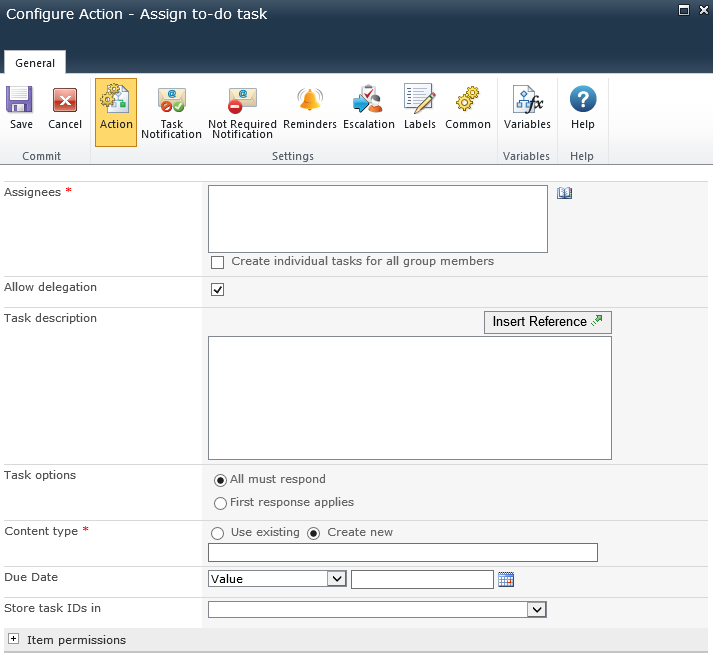
Ribbon Option: Action
The Assignees list contains all users or groups that will be assigned the task when the workflow is runs.
Users can be:
- Entered directly using their username, email address or full name and will be resolved where possible against the SharePoint user list or Active Directory.
- Search for users, click on the address book icon on the right.
Select People and Groups
To search for users, click on the address book icon on the right.
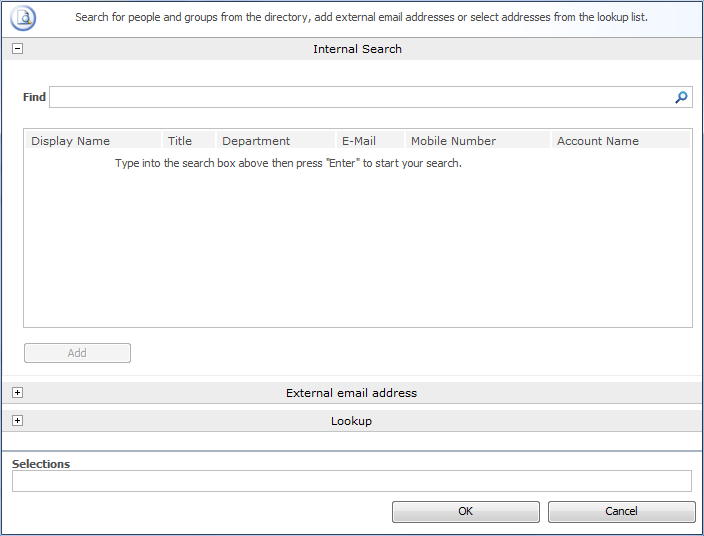
The configuration dialog allows the workflow designer to search for and/or add users to the Assignees list by one or more of the following methods:
- Internal Search: Entering a partial display name, email or user account name and clicking on the magnifying glass will provide a list of matching users and groups from SharePoint as well as Active Directory.
- External email address: Enter an external email address manually. Where possible Nintex Workflow will resolve this to an actual user account.
- Lookup: Provides the option of adding a dynamic reference as an approver. e.g. Workflow variable, list field.
Click the title bar to expand or collapse each option.
Create individual tasks for all group members
In the case when a group is assigned the task and Create individual tasks for all group members checkbox is:
- not selected, all users in that group will receive the task notification. The first respondent will represent the entire group.
- selected, an individual task will be assigned to every member of the group.
Groups will only be expanded to one level. Groups within groups will not be expanded.Users can be entered directly using their username, email address or full name and will be resolved where possible against the SharePoint user list or Active Directory.
When this option is selected, if the assignee field of the task is changed, Nintex Workflow will record the change as a task delegation and the new assignee will receive the Response Required Notification. If this option is not selected, Nintex Workflow will not track the change to the assignee and Nintex Workflow reports and web parts will not reflect the new assignee.
Allows entry of dynamic text that will display on the task response form. This can be used to communicate additional information about the task to the responding user. References can also be inserted using the Inserting reference fields feature.
There are two behavioural alternatives in this action to instruct Nintex Workflow how to handle tasks with multiple assignees. These are:
- All must respond: All assignees must complete the task before the workflow will continue.
- First response applies: After the first response is received, all other tasks will be set to 'not required'.
Choose to use an existing, or instruct Nintex Workflow to create a new content type.
If using an existing content type, select any content type that inherits from 'Workflow Task' but does not inherit from 'Nintex Workflow Task'. The 'Nintex Workflow Task' content type is reserved for request approval and request review actions. Also if selecting an existing content type, specify the value to assign to each field when the task is created.
Set a date for the task to be completed by.
When the workflow runs, the ID given to each task that is created will be stored into the selected collection variable.
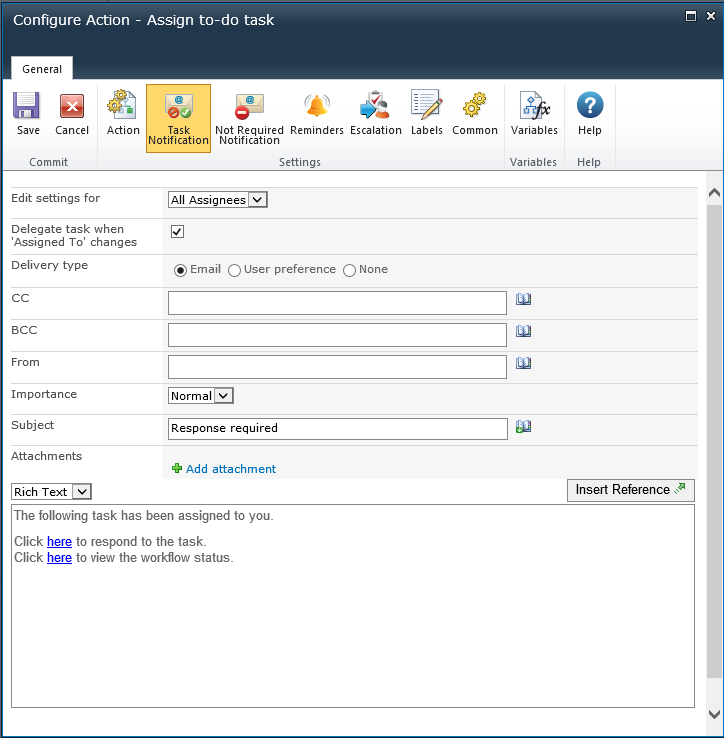
Changing this setting from the default All Assignees, allows the configuration of unique notification options for each Assignee in the list.Unless specifically configured, assignees will use the All Assignees settings. To override settings for a specific Assignee, select their name from the drop down list.Changes to All Assignees will not affect users who are given custom settings.

When this option is selected, if the assignee field of the task is changed, Nintex Workflow will record the change as a task delegation and the new assignee will receive the Response Required Notification. If this option is not selected, Nintex Workflow will not track the change to the assignee and Nintex Workflow reports and web parts will not reflect the new assignee.
Delivery type is the method of delivering the notification to the recipients.
Available delivery options; None, Email, User preference or Instant Message (if enable on the server). For information on User preference, please refer to the Configuring user preferences.
Please note: Nintex does not provide support for troubleshooting email, SMS or LCS systems.
The CC field sets read only users who will receive the notification. CC recipients are not able to respond to the tasks.
To set the CC field click on
to open the Select People and Groups configuration dialog.
The BCC field sets read only users who will receive the email. BCC recipitants are not able to respond to the tasks. Other users addressed in the email via the To, CC and BCC fields will not be able to see any addresses in the BCC field. To set the BCC field, enter the account name, or alternatively, select the address book icon for additional options.
The From field sets the user or domain group that will appear as the sender of the message. This setting applies to emails only. If no From user or domain group is specified, the From address configured in Global Settings will be used.
The priority of the notification. This is only applicable when using email notifications.
The Subject is the title of the notification being sent. If an OCS/LCS message is being sent it will be pre-pended to the body of the notification.
Added manually or by clicking on
, to use Insert reference fields from within the runtime instance of the workflow.
Allows file attachments to be added to the notification. You can specify multiple URLs by separating each URL with a semicolon. You can also specify multiple URLs by referencing a collection variable.
Files will not be received by a user when SMS or IM is selected as the delivery method. For information on User preference, please refer to the Configuring user preferences.
This sets the format of the email.
Selecting:
The body of the notification will adapt depending on whether the Rich Text or Plain Text format is selected. Within the space provided enter the content for the notification as straight text, also available are Insert reference fields from within the workflow.
Ribbon Option: Not Required Notification
Sent when the user no longer needs to respond to the task. This can occur when:
- A task is assigned to multiple users but only one is required to respond.
- The workflow is terminated prior to the task being processed.
- An error occurs in the workflow at runtime.
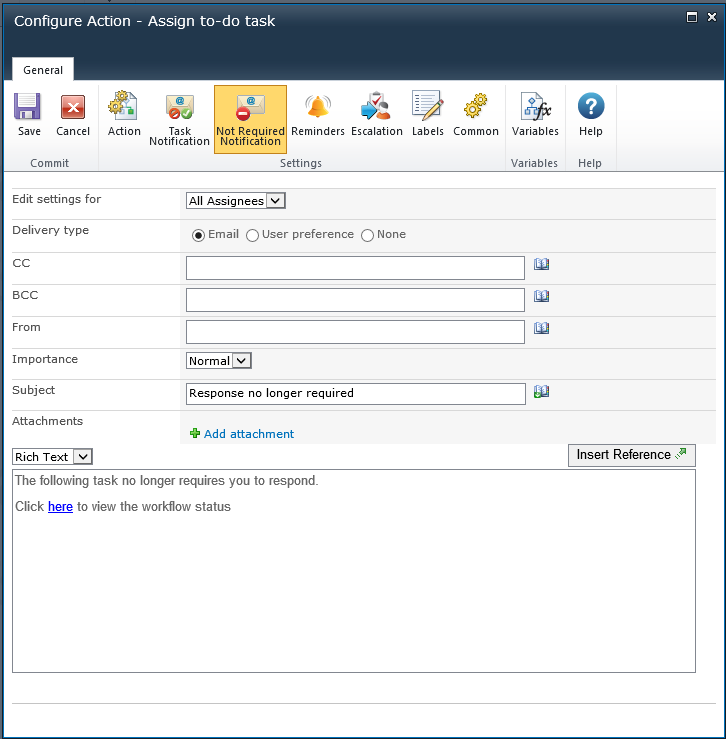
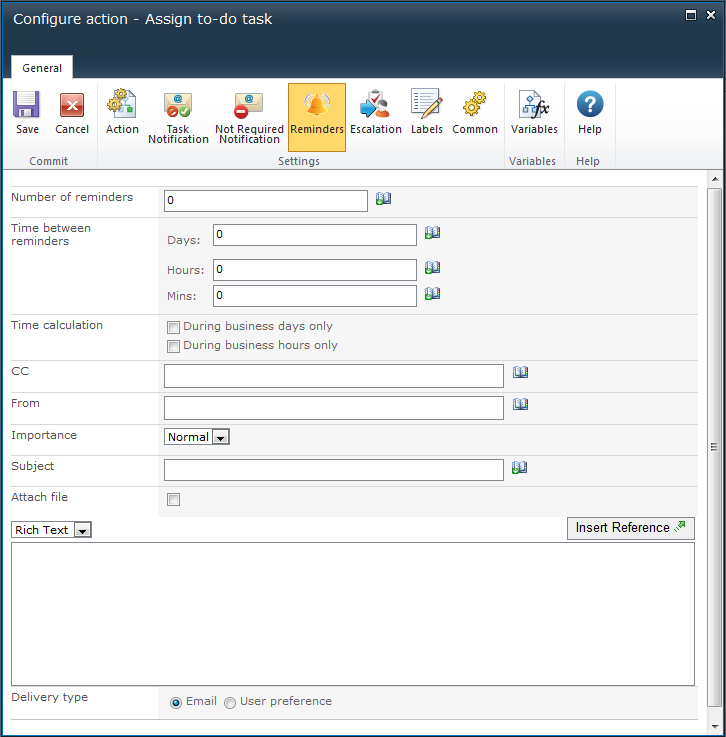
The number of reminders to be sent.
The delay before sending each reminder in days, hours and minutes.
The total time is calculated by summing all fields, regardless of the Time calculation option selected. For example, 4 days and 4 minutes will be calculated as 96 (24x4) hours and 4 minutes.
Specifies whether or not hours outside the work week should be included when counting down to send a reminder.
The During business days only option will specify that weekends or holidays are not included in the count down, but after hours on a business day are.
Example:
- The task is assigned Friday morning and is configured to wait 1 day before sending a reminder (the work week is defined as Monday to Friday)
- A reminder will be sent Monday morning, weekends are not included in the count down.
The During business hours only option specifies that only business hours are used in the count down.
Example:
- The task is assigned Wednesday at 4pm and is configured to wait 4 hours before sending a reminder (the work day is defined as Monday to Friday, 8am to 5pm).
- A reminder will be sent at 11am on Thursday, after business hours are not included in the count down.
If neither option is selected, all hours will be included in the count down.
Examples:
- The task is assigned Friday morning and is configured to wait 1 day before sending a reminder.
- A reminder will be sent Saturday morning, weekends are included in the count down.
- The task is assigned Wednesday at 4pm and is configured to wait 4 hours before sending a reminder.
- A reminder will be sent at 8pm on Wednesday, after business hours are included in the count down.
Escalation is optional, there are two possible escalation paths:
